New York (BRAMA) Oct 21 - The traveling exhibition "Gold of the Nomads: Scythian Treasures from the Ancient Ukraine" has finally made its way to New York City. It opened at the Brooklyn Museum of Art last Friday, and will be on display through January 21, 2001.
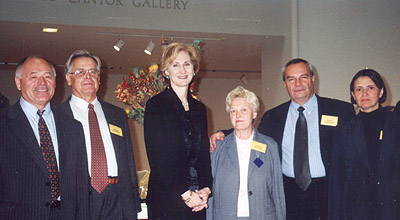
- ©HK/BRAMA, 10/12/00
(l-r)
Dr. Denys Kozak, Deputy Director, Institute of Archeology of the National Academy of Sciences of Ukraine (NASU);
Prof. Serhyi Kryzhytsky (NASU);
Dr. Ellen Reeder, Deputy Director for Art, Brooklyn Museum of Art;
Svitlana Korets'ka, Research Asst., National Museum of the History of Ukraine (NMHU);
Serhyi Chaikovsky, General Director, (NMHU);
Ilena Pidvysots'ka, Research Asst., Museum of Historical Treasures of Ukraine.
|
This exciting collection features more than 170 objects excavated from "kurhans" or "mohyly" (burial mounds) in the steppes of Ukraine. Included in the exhibit are the finest examples of elaborate gold jewelry, clay urns, decorative elements from garments, and many other items depicting life in ancient Scythia. Curated by Dr. Ellen Reeder, Deputy Director for Art at the Brooklyn Museum of Art, the project has been in the works since 1997.
Dr. Reeder first encountered Scythian artifacts at the Hermitage Museum in 1974 while working on her dissertation in classical Greek metalwork. She determined at that time to work towards compiling a definitive work on Scythian archeological finds complete with detailed high quality photographs that are so very critical for scholars in this field. Dr. Reeder underscores the fact that it took 25 years to realize her dream, and is fittingly proud of her accomplishment after all this time.
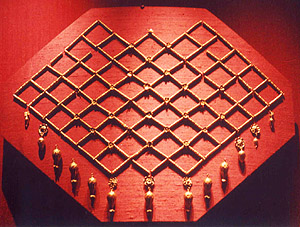
- ©HS/BRAMA, 10/12/00
Gold plaques for a garment, ca. 350-300; from Haimanova Mohyla, near village of Balky, Vasylivs'kyi Raion, Zaporizhs'ka Oblast'.
This lattice pattern of beading and gold pendants was used as a chest decoration on a garment. Cat#127.
|
Listening to Dr. Reeder describe her experiences traveling throughout Ukraine and working with her Ukrainian colleagues, one can hear the enthusiasm with every word as she utters. Ask Dr. Reeder what she thought of Ukraine and out comes the moving declaration, "I love the land! I think the land in Ukraine is some of the most beautiful land in the world. I've never seen anything like it."
Reeder also has a great deal of respect for her counterparts in Ukraine, and expressed her gratitude to the many individuals that she worked with at the Museum of Historical Treasures of Ukraine (MHTU), National Museum of the History of Ukraine (NMHU), and the National Academy of Sciences of Ukraine (NASU). She was especially complimentary of the efforts of the interpreter, Nadia Shotskaya, who managed to capture all the nuances of the technical archeological terminology exchanges between Dr. Reeder and the Ukrainian teams. And, incidentally, First Lady Hillary Rodham Clinton has lent support to the exhibition by being named Honorary Chair.
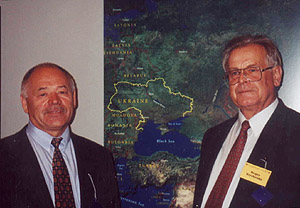
- ©HK/BRAMA, 10/12/00
Dr. Kozak and Prof. Kryzhytsky flank the outline of Ukraine on the topographical wall map.
|
Accompanying the exhibit to the United States are Ukrainian experts Serhyi Chaikovsky, General Director NMHU, Dr. Denys Kozak, Deputy Director, Institute of Archeology of NASU, Prof. Serhyi Kryzhytsky (NASU), and research assistants Svitlana Korets'ka (NMHU) and Ilena Pidvysots'ka from MHTU.
The highly acclaimed exhibition has already toured San Antonio, Baltimore, and Los Angeles. After the Brooklyn Museum, it will travel to Ontario, Kansas City, and finally on to Paris, France.
Brooklyn Museum of Art Press Release
Exhibition: October 13, 2000-January 21, 2001
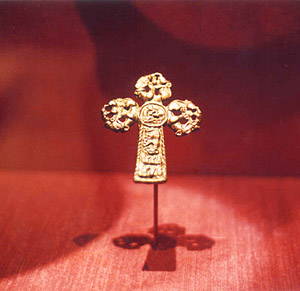
- ©HS/BRAMA, 10/12/00
Horse frontlet, 5th c. bronze; decorative piece for a horse harness; may have had a gold overlay at one time.
|
Gold of the Nomads: Scythian Treasures from the Ancient Ukraine is the first major exhibition of Scythian art in the United States in more than a quarter century. Owned by the fierce nomadic horsemen who roamed the European steppes from the seventh to the third centuries B.C., these extraordinary objects will be on view at the Brooklyn Museum of Art from October 27, 2000 through January 21, 2001. The exhibition includes more than 170 exquisitely crafted pieces, many of them excavated in the last decade. Among them are articles of personal adornment, ceremony, and battle created by Scythian artists and by superb Greek goldsmiths.
All of the objects in the exhibition are on loan from the Museum of Historical Treasures of Ukraine, The Institute of Archaeology of the Academy of Sciences of Ukraine, and the State Historical Archaeological Preserve of Ukraine..
The exhibition has been organized by the Walters Art Gallery, Baltimore, where it appeared in the spring and the San Antonio Museum of Art. It is supported by an indemnity from the Federal Council on the Arts and Humanities. Gold of the Nomads is curated by Dr. Ellen Reeder, Deputy Director for Art at the Brooklyn Museum of Art, in collaboration with Dr. Gerry Scott III, Curator of Ancient Art at the San Antonio Museum of Art.
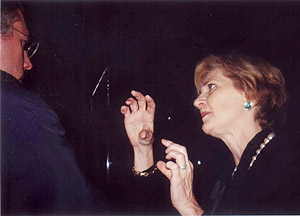
- ©HK/BRAMA, 10/12/00
Dr. Reeder's passion for this exhibition is evident as she explains a fine point about Scythian gold to a museum visitor.
|
Many of the recently excavated objects in the exhibition constitute a new chapter, even a new book on the dialogue between the ancient Aegean world, the ancient Near East, and the steppes that extend from north of the Black Sea as far as the Altai Republic near Mongolia. "This exhibition and the accompanying catalogue provide an opportunity to explore a new frontier in the discipline of archaeology and a window into a mysterious, vanished culture," states Dr. Reeder.
Although other nomadic tribes that had a turn in dominating this vast region, like the Huns and the Mongols, survive through a history of tales of their brutal conquests, the Scythians have also left in their lavishly provisioned tombs, one of the most complete and extraordinary material records of any nomadic people.
Most of these spectacular objects are portable in keeping with the nomadic lifestyle of the Scythians. Many are in the animal style associated with the central Asian steppes, while some reflect the strong influence of ancient Near Eastern culture. Other objects reveal a fusion of pure Scythian style with the Near East and the Greek world.
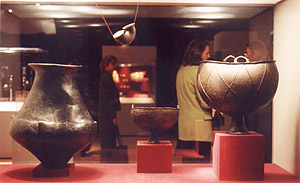
- ©HS/BRAMA, 10/12/00
Clay storage vessel (left) used for grain and flour dates back to the 6th century; it was excavated in Cherkas'ka Oblast.
In the center is a 5th c. bronze cauldron from Khersons'ka Oblast'.
On the right, a 4th c. bronze cauldron from Zaporizhs'ka Oblast'.
Hanging in the center is a clay cylindrical vessel from 6th century Cherkas'ka Oblast.
Cat#26,27,28,25.
|
The first exhibition to come to the United States since Ukraine achieved independence in 1991, Gold of the Nomads is also the largest and most complete exhibition ever assembled from Scythian art organized by Ukraine. It features a broad range of objects, many of which have never been seen outside Ukraine. These virtually unknown masterpieces include a gold helmet, excavated in 1988, bearing scenes in relief of Scythian combat, the style of which is clearly influenced by Attic Greek red-figure vase painting of the fifth century B.C.; a nearly foot-high object, unearthed in 1990, covered with intricately intertwined animal combat scenes that is thought to have served as a finial; and a series of gold cut- out plaques from a bow and arrow case that depict winged dragons crafted in a blend of the animal and Near Eastern styles and a leafy- footed, scaled man that was excavated in 1991.
More than 2,500 years ago the Scythian culture flourished for a few brief centuries. The Scythians originated in the central Asian steppes sometime in the early first millennium B.C. After migrating to what is now Ukraine, in about the seventh century B.C., they dominated the vast expanse of the steppes that stretched from the Danube, east across what is modern Ukraine and east of the Black Sea into Russia. For nearly three centuries they swept across the steppes with a military skill and ferocity that made them nearly invincible.
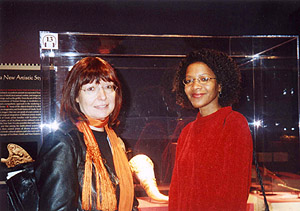
- ©HK/BRAMA, 10/12/00
Virlana Tkacz (l) and Wanda Phipps, both of Yara Arts Group, were on hand for a sneak preview of the exhibition.
|
The Scythians and their elaborately ornamented gold objects also reveal a tale of interaction with the Greek world, which purchased grain, fur, and amber from the ferocious warriors. Profits from this trade brought the Scythians the wealth to indulge their taste for elaborate objects ranging from exquisite jewelry for themselves to elaborate ornamentation for their horses.
This prosperity may well have been what caused the Scythians to abandon their nomadic existence and to allow another hardier, nomadic tribe known as the Samatians to take control of the vast territory that the Scythians had dominated. The exhibition will also include several superb Sarmatian gold objects.
Modern knowledge of the Scythians is based on archaeological excavations of their elaborately equipped burial mounds known as kurhans. Ongoing explorations continue to recover an astonishing wealth of gold and silver objects, including horse trappings, armor, weaponry, jewelry, and ceremonial adornment with which powerful members of these ancient peoples were entombed, along with retinues of attendants. Scythian gold objects were first discovered in the 18th century. The Russian Empress Catherine the Great then ordered their systematic study, launching what became the field of Scythian archaeology. The past two decades have yielded some of the most exceptional finds, as archaeologists continue to explore some of the more than 40,000 yet unexcavated kurhans in Ukraine.
Tickets, which will also include general admission, will be required for Gold of the Nomads. Ticket prices are $8 Adults, $6 older adults and students 18 and over with valid I.D., $4 ages 13-17; free to children ages 12 and under accompanied by an adult.